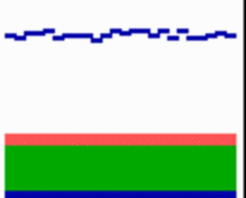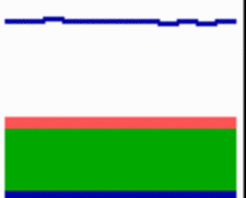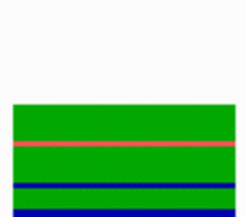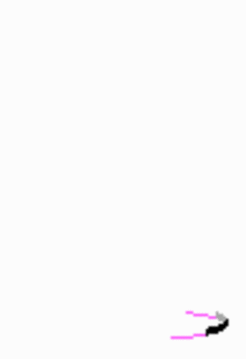A simple BASIC - program
This short program allows the simulation of essential patterns in development: the generation of gradients, of periodic structures, of polar patterns that oscillate and of initiation of leaves in a helical arrangement (phyllotaxis). It is written in BASIC The program can be changed and recompiled with compilers that are freely available on the web. Details are given here. For an executable file in a compressed and the source code form click here. The resulting screens are given at the end of this page. A short introduction how to write such a program is given in a commented PowerPoint presentation [PPT]
'------------------------------------------------------------
' A simple program to simulate biological pattern formation
' (C) Hans Meinhardt, MPI Tuebingen
DEFDBL A-G
DEFDBL O-Z
DEFINT H-N
ON ERROR GOTO checkerror
' A simple program to simulate biological pattern formation
' (C) Hans Meinhardt, MPI Tuebingen
' The program is written in BASIC. Convenient compilers are
' Freebasic for Windows or Unix, PowerBasic 3.5 for DOS
' Microsoft QB 4.5, or QBX
' i = 1 ... n= Number of cell
imax = 640: DIM ax(imax), bx(imax), cx(imax), s(imax)
simtyp$ = "p"' First simulation: periodic pattern
start:
SELECT CASE simtyp$
CASE "p": text$ = "Periodic Pattern"
KT = 100 'Number of displays
KP = 20 ' 'number of iterations between the displays
'it*ip = number of iterations in total
n = 40' number of cells
DA = .01' Diffusion of the activator
RA = .02' Removal rate of the activator
BA = .001 ' Activator-independent activator production rate
DB = .4' Diffusion of the inhibitor
RB = .03' Removal rate of the inhibitor
RC = 0' only Activator-Inhibitor system, Substance c not in use
fa = 60: fb = 60: fc = 0' Scaling factors for display
igraph = 1: boundary$ = "tight"
CASE "g": text$ = "Graded Distribution"
KT = 50: n = 12: KP = 200
DA = .004: RA = .0015: BA = .0001: DB = .4: RB = .0025: RC = 0
igraph = 1: boundary$ = "tight": fa = 60: fb = 60: fc = 0
CASE "o": text$ = "Pattern destabilizes itself: polar oscillations"
KT = 200: KP = 500: n = 12: DA = .003: RA = .002: BA = .05
DB = .4: RB = .003: DC = .001: RC = .0001:
igraph = 1: fa = 40: fb = 50: fc = 50: boundary$ = "tight"
CASE "h": text$ = "Pattern destabilizes itself: helical phyllotaxis"
KT = 144: KP = 400: n = 40: DA = .005: RA = .004: BA = .05
DB = .4: RB = .006: DC = .003: RC = .0002:
igraph = 2: fa = 40: fb = 50: fc = 50' Graph-type and Scaling
boundary$ = "cyclic"
CASE ELSE: GOTO TheEND ' each other key: the end
END SELECT
REM ----------- Initial conditions --------------------------
FOR i = 1 TO n
s(i) = RA * (.99 + .02 * RND)'"Source density" = Production of the
'activator, proportional to the decay rate +- 2% fluctuation
ax(i) = 1'general initial activator concentration
bx(i) = 1'general initial inhibitor concentration
cx(i) = 0: NEXT
SCREEN 12: t = TIMER: CLS 'Initialization of graphic and timing
WINDOW (1, 1)-(640, 480) ' coordinate system
LINE (1, 1)-(640, 480), 15, BF 'background white
LOCATE 30, 1:
PRINT "green = Activator, red = Inhibitor, blue = Source density; any key: stop";
LOCATE 1, (80 - LEN(text$)) / 2: PRINT text$
continuo: ' if calculation is continued...
DeltaWi = 6.28 / n: yzyl = 30: radius = 100
perspective = .15' for cylinder of phyllotaxis
idx = 600 / n: fs = 350 / RA 'Pixel-size of a cell
FOR itot = 0 TO KT' total numberplots
FOR iprint% = 1 TO KP' Calculations between plots
SELECT CASE boundary$
CASE "cyclic"
al = ax(n): bl = bx(n): cl = cx(n)'al is the concentration in the cell
'left of the actual cell. Left-most cell = last cell = cyclic
ax(n + 1) = ax(1)' Concentration in a virtual cell on the right
bx(n + 1) = bx(1)' equal concentration of the left-most cell
cx(n + 1) = cx(1)' for all substances
CASE "tight"
al = ax(1): bl = bx(1): cl = cx(1)'al is the concentration in the cell
'left of the actual cell. Left-most cell = virtual cell with the same
'concentration
ax(n + 1) = ax(n)' concentration in a virtual cell to the right of the
bx(n + 1) = bx(n)' right-most cell is equal to the concentration in the
cx(n + 1) = cx(n)' right-most cell, this for all substances
END SELECT
REM ---------- Reactions ------
FOR i = 1 TO n' i = current cell, n = right cell
a = ax(i) 'local activator-concentration
b = bx(i) 'local inhibitor1-concentration
c = cx(i) 'local inhibitor2-concentration
'Calculation of a new activator and inhibitor concentration in cell i
Diffactivator = DA * ((al - a) + (ax(i + 1) - a)) 'Exchange with neighbor
ax(i) = a + s(i) * (a * a + BA) / (b + c) - RA * a + Diffactivator
bx(i) = b + s(i) * a * a - RB * b + DB * ((bl - b) + (bx(i + 1) - b))
IF RC > 0 THEN ' c only in oscillating patterns and phyllotaxis
cx(i) = c + RC * a - RC * c + DC * ((cl - c) + (cx(i + 1) - c))
END IF
al = a: bl = b: cl = c'The not yet changed concentrations
'are used as left cell concentrations in the subsequent cell
NEXT i
NEXT iprint%
REM ----------------Plot -------------
SELECT CASE igraph
CASE 1' Each cell is a rectangle
LINE (20, 45)-(620, 50), 1, BF
x1 = 20' Position of the first rectangle
FOR i = 1 TO n
x2 = x1 + idx
afl = 51 + ax(i) * fa: LINE (x1, 51)-(x2, afl), 2, BF'green=activator
LINE (x1, afl)-(x2, 450), 15, BF 'remaining part white: erase old plot
bfl = 51 + bx(i) * fb: LINE (x1, bfl)-(x2, bfl + 10), 12, BF
sfl = 51 + s(i) * fs: LINE (x1, sfl)-(x2, sfl + 3), 1, BF
IF RC > 0 THEN
cfl = 51 + cx(i) * fc: LINE (x1, cfl)-(x2, cfl + 3), 13, BF 'second inhibitor
END IF
x1 = x2: NEXT
DO UNTIL TIMER - t > .1: LOOP: t = TIMER'slow down if computer is too fast
CASE 2 ' transparent cylinder for phyllotaxis
LOCATE 30, 1: PRINT "black/grey = high activator concentration, y-coordinate=time, any key=stop";
wi1 = 0: n21 = n / 2 + 1 'front or back of the cylinder
yzyl = yzyl + 3'Next plot one pixel row higher
FOR ix% = 1 TO n'Black if above a threshold
wi2 = wi1 + DeltaWi
ico = 0: IF ix% < n21 THEN ico = 7 'Cells are gray if seen from inside
IF ax(ix%) > 1 THEN
CIRCLE (320, yzyl), radius, ico, wi1, wi2, perspective'Several lines
CIRCLE (320, yzyl + 1), radius, ico, wi1, wi2, perspective'on top of
CIRCLE (320, yzyl + 2), radius, ico, wi1, wi2, perspective'each other
END IF
wi1 = wi2: NEXT ix%
IF icount = 0 THEN CIRCLE (320, yzyl), radius, 10, , , perspective
icount = icount + 1 'green circle for clarity
IF icount = 3 THEN icount = 0
END SELECT
IF INKEY$ > "" THEN EXIT FOR 'any key -> exit
NEXT itot
LOCATE 30, 1: PRINT "c = continue; s = start again; n = new type of ";
PRINT "simulation, ... other keys = end";
a$ = "": DO UNTIL a$ > "": a$ = INKEY$: LOOP' wait for key
SELECT CASE a$
CASE "c", "w": GOTO continuo
CASE "s": GOTO start
CASE "n": LOCATE 30, 1:
PRINT "p = Periodic; g= gradient, o = oscillating polar, h = helical,other key = end";
simtyp$ = "": DO UNTIL simtyp$ > "": simtyp$ = INKEY$: LOOP' wait for key
GOTO start
END SELECT
TheEND:
LOCATE 30, 1: t = TIMER
PRINT ".... a program for simulation of biol. pattern formation;(c) Hans Meinhardt";
DO UNTIL TIMER - t > 3: LOOP
END
checkerror:
IF ERR > 0 THEN PRINT "There was an error, code "; ERR, : SLEEP
RESUME NEXT
'-------------------End of the Program-------------------------------
Running this program lead to the following screens:
- Periodic pattern

Gradients

Oscillations of polar patterns

Phyllotaxis




